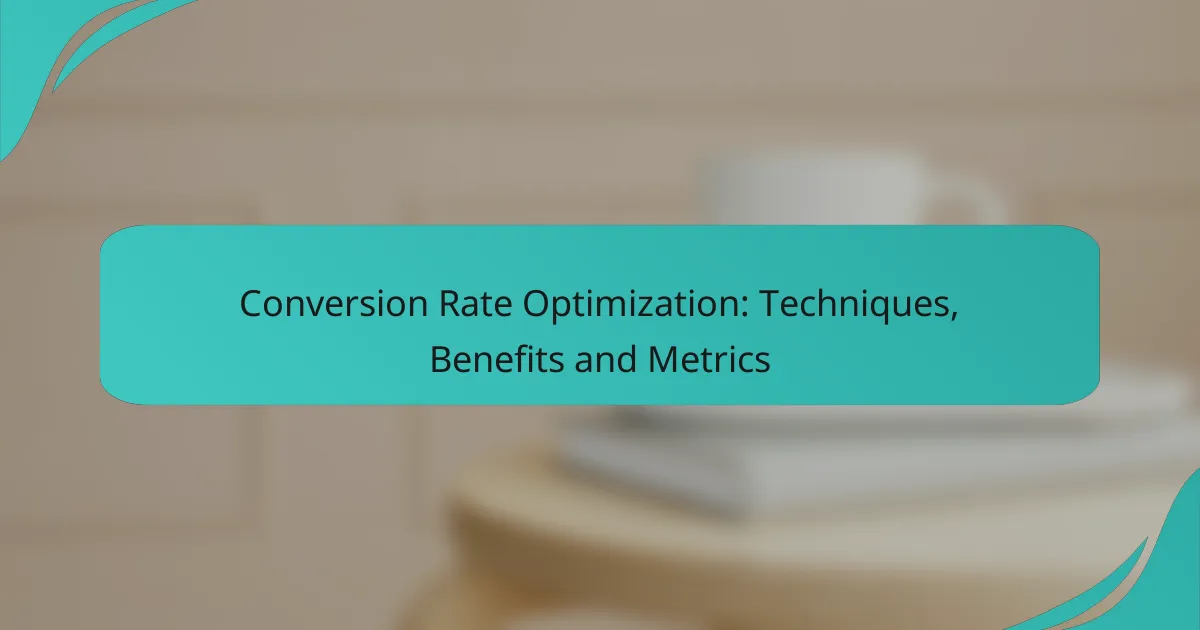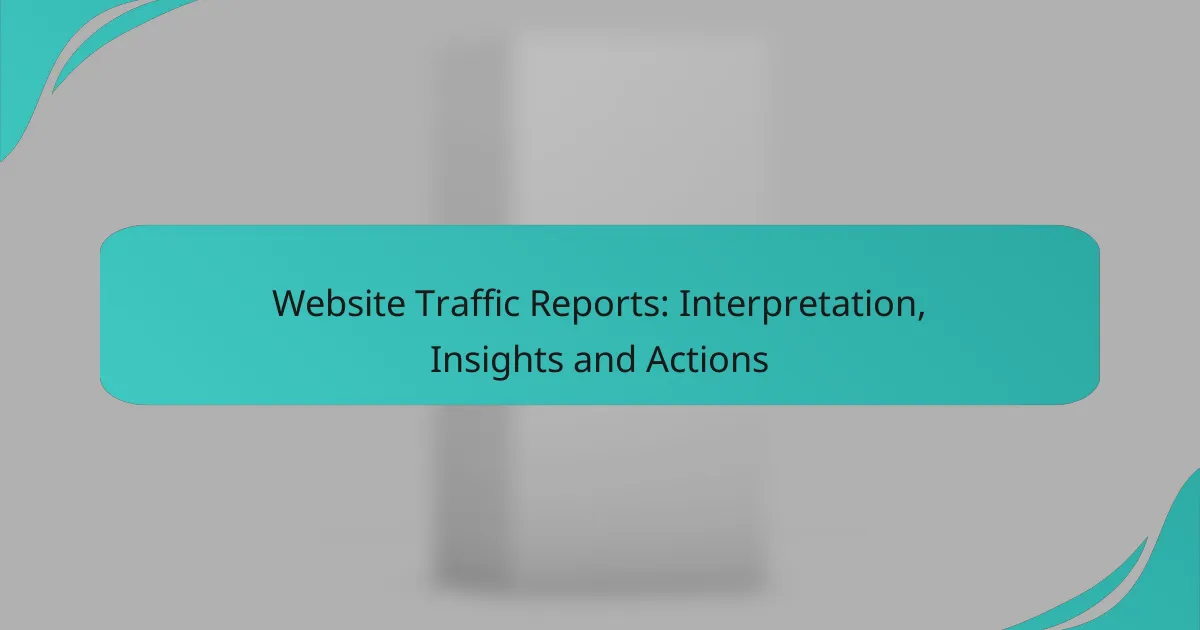Conversion rate optimization (CRO) is essential for maximizing the effectiveness of a website in turning visitors into customers. By employing techniques such as A/B testing, landing page optimization, and personalization, businesses can significantly enhance user experience and engagement. Measuring the success of these strategies through key metrics allows companies to refine their approach and achieve better online performance.
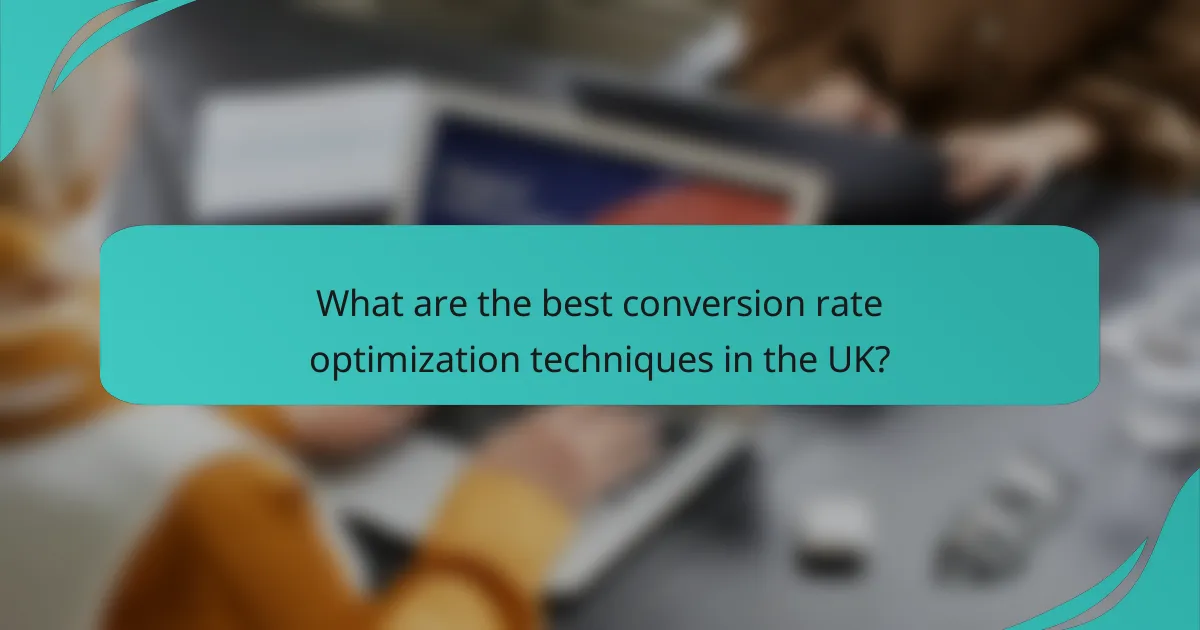
What are the best conversion rate optimization techniques in the UK?
The best conversion rate optimization techniques in the UK focus on enhancing user experience and increasing engagement to drive conversions. Key methods include A/B testing, landing page optimization, personalization strategies, improving website speed, and utilizing heatmaps.
A/B testing
A/B testing involves comparing two versions of a webpage to determine which one performs better in terms of conversion rates. By showing different users different versions, you can analyze metrics like click-through rates and sales to identify the more effective option.
To implement A/B testing, select a single variable to change, such as a headline or call-to-action button. Run the test for a sufficient duration to gather reliable data, typically a few weeks, depending on your traffic volume.
Landing page optimization
Landing page optimization focuses on improving the design and content of landing pages to boost conversions. This includes ensuring a clear value proposition, compelling visuals, and a straightforward call to action.
Consider using concise headlines, engaging images, and testimonials to build trust. Regularly review analytics to identify areas for improvement, such as high bounce rates or low engagement times.
Personalization strategies
Personalization strategies tailor the user experience based on individual preferences and behaviors. This can involve customizing content, product recommendations, or offers based on user data.
Utilize tools that track user behavior to create targeted campaigns. For example, showing returning visitors products they viewed previously can significantly increase conversion rates.
Improving website speed
Website speed is crucial for retaining visitors and enhancing conversions. A slow-loading site can lead to high bounce rates, as users are less likely to wait for pages to load.
Aim for a loading time of under three seconds. Optimize images, reduce server response times, and leverage browser caching to improve speed. Regularly test your site’s performance using tools like Google PageSpeed Insights.
Utilizing heatmaps
Heatmaps visually represent user interactions on your website, showing where users click, scroll, and spend the most time. This data helps identify which elements are engaging and which are not.
Implement heatmap tools to analyze user behavior and adjust your design accordingly. For instance, if users are ignoring a call-to-action button, consider repositioning it or changing its color to enhance visibility.
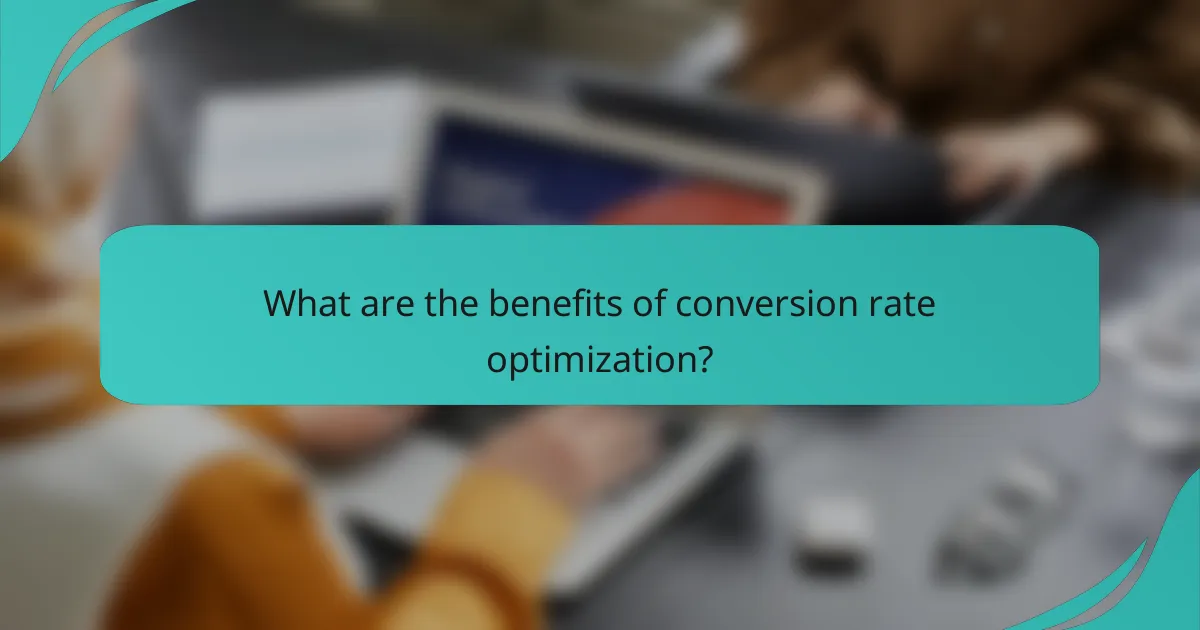
What are the benefits of conversion rate optimization?
Conversion rate optimization (CRO) enhances the effectiveness of a website in turning visitors into customers. By implementing various techniques, businesses can significantly improve their online performance and achieve better results.
Increased revenue
One of the primary benefits of conversion rate optimization is increased revenue. By optimizing the user journey and reducing friction points, businesses can convert a higher percentage of visitors into paying customers. For example, even a small increase in conversion rates, say from 2% to 3%, can lead to substantial revenue growth, especially for e-commerce sites with high traffic.
To maximize revenue, consider A/B testing different elements such as call-to-action buttons, product descriptions, and pricing strategies. This data-driven approach helps identify what resonates best with your audience, leading to more effective sales strategies.
Improved user experience
Conversion rate optimization directly contributes to an improved user experience by making websites more intuitive and user-friendly. A seamless navigation process, fast loading times, and clear information can significantly enhance how visitors interact with a site. For instance, simplifying the checkout process can reduce cart abandonment rates and encourage purchases.
Focus on user feedback and analytics to identify pain points. Regularly updating your website based on user interactions can lead to a more satisfying experience, ultimately boosting conversion rates.
Higher customer retention
Higher customer retention is another key benefit of conversion rate optimization. When users have a positive experience on your site, they are more likely to return for future purchases. Implementing strategies such as personalized recommendations and loyalty programs can encourage repeat business.
To foster retention, ensure consistent communication through email marketing and follow-up surveys. Engaging with customers after their initial purchase can build loyalty and increase the likelihood of them becoming repeat buyers.

How to measure conversion rate optimization success?
Measuring the success of conversion rate optimization (CRO) involves tracking specific metrics that indicate how well your website or landing page converts visitors into customers. Key indicators include conversion rates, customer feedback, and the effectiveness of various marketing strategies.
Key performance indicators
Key performance indicators (KPIs) are essential for assessing the effectiveness of your CRO efforts. Common KPIs include conversion rate, average order value, and customer acquisition cost. Monitoring these metrics helps identify which strategies yield the best results.
For example, a conversion rate of 2-5% is often considered average for e-commerce sites, while a higher rate may indicate successful optimization. Regularly reviewing these KPIs allows for timely adjustments to improve overall performance.
Conversion rate tracking
Conversion rate tracking involves measuring the percentage of visitors who complete a desired action, such as making a purchase or signing up for a newsletter. Tools like Google Analytics can help you set up goals and track conversions effectively. Ensure that your tracking is set up correctly to capture accurate data.
Consider segmenting your audience to analyze conversion rates across different demographics or traffic sources. This can reveal insights into which segments respond best to specific campaigns, allowing for more targeted optimization efforts.
Customer feedback analysis
Analyzing customer feedback is crucial for understanding user experience and identifying areas for improvement. Collect feedback through surveys, reviews, and user testing to gain insights into customer satisfaction and pain points. This qualitative data can complement quantitative metrics for a fuller picture of performance.
For instance, if customers frequently mention difficulty navigating your site, this may indicate a need for a more user-friendly design. Actively addressing feedback can lead to higher conversion rates and improved customer loyalty.

What tools are available for conversion rate optimization?
Several tools are available for conversion rate optimization (CRO), each offering unique features to enhance website performance and user experience. These tools help analyze user behavior, conduct A/B testing, and gather insights to improve conversion rates effectively.
Google Analytics
Google Analytics is a powerful tool that tracks and reports website traffic, providing insights into user behavior and conversion metrics. It allows you to set up goals and funnels to see how users navigate your site, helping identify drop-off points and areas for improvement.
To maximize its effectiveness, ensure you configure event tracking for specific actions like form submissions or product purchases. Regularly review your conversion reports to understand trends and make data-driven decisions.
Optimizely
Optimizely specializes in A/B testing and multivariate testing, enabling you to experiment with different website elements to see what drives higher conversions. Its user-friendly interface allows marketers to create and run tests without needing extensive coding knowledge.
When using Optimizely, focus on testing one variable at a time for clearer results. Consider running tests for a minimum of two weeks to gather sufficient data before making conclusions based on the results.
Hotjar
Hotjar provides heatmaps, session recordings, and feedback polls to visualize user interactions on your website. This qualitative data complements quantitative analytics by showing how users engage with your site and where they encounter obstacles.
Utilize Hotjar’s feedback tools to gather direct insights from users about their experience. Regularly analyze heatmaps to identify popular areas and potential issues, allowing you to make informed adjustments to enhance user experience and increase conversions.
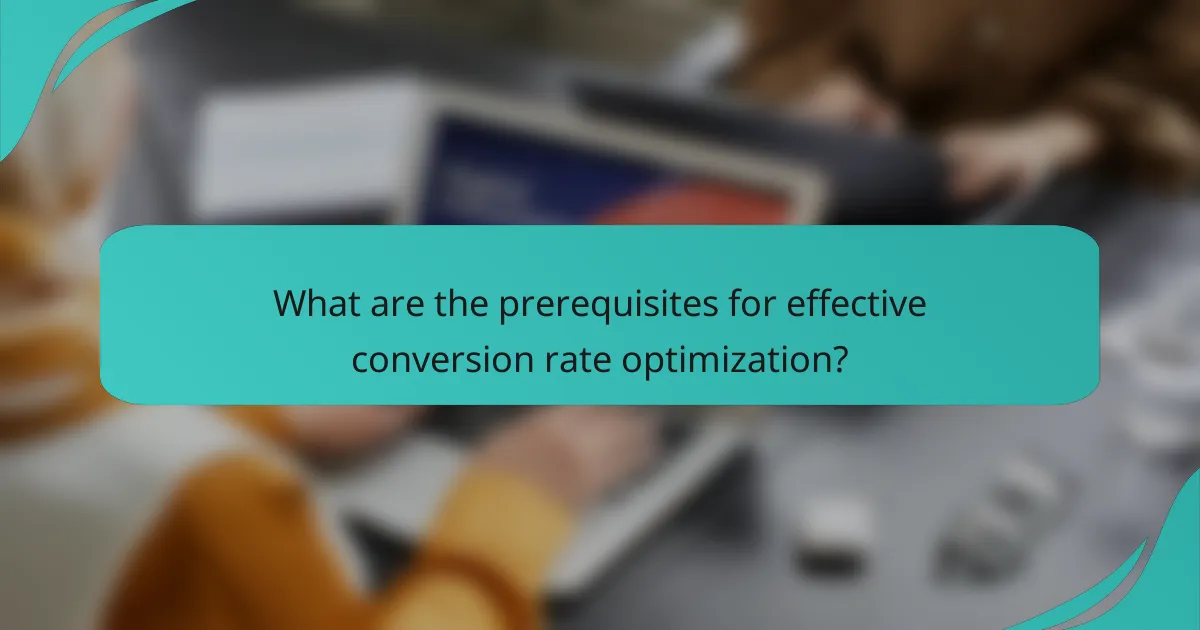
What are the prerequisites for effective conversion rate optimization?
Effective conversion rate optimization (CRO) requires a clear understanding of your audience and well-defined goals. These prerequisites ensure that your strategies are targeted and measurable, leading to improved conversion rates.
Understanding target audience
To optimize conversion rates, you must first identify and understand your target audience. This involves researching demographics, preferences, and behaviors to create customer personas that accurately reflect your potential clients.
Utilize tools like surveys, analytics, and user testing to gather insights about your audience. Knowing their pain points and motivations allows you to tailor your messaging and design to meet their needs effectively.
Setting clear goals
Establishing clear, measurable goals is essential for successful CRO. Goals should be specific, attainable, and relevant to your business objectives, such as increasing newsletter sign-ups or boosting product sales.
Consider using the SMART criteria (Specific, Measurable, Achievable, Relevant, Time-bound) to define your goals. For example, instead of aiming to “increase sales,” set a goal to “increase sales by 20% over the next quarter.” This clarity helps in tracking progress and adjusting strategies as needed.
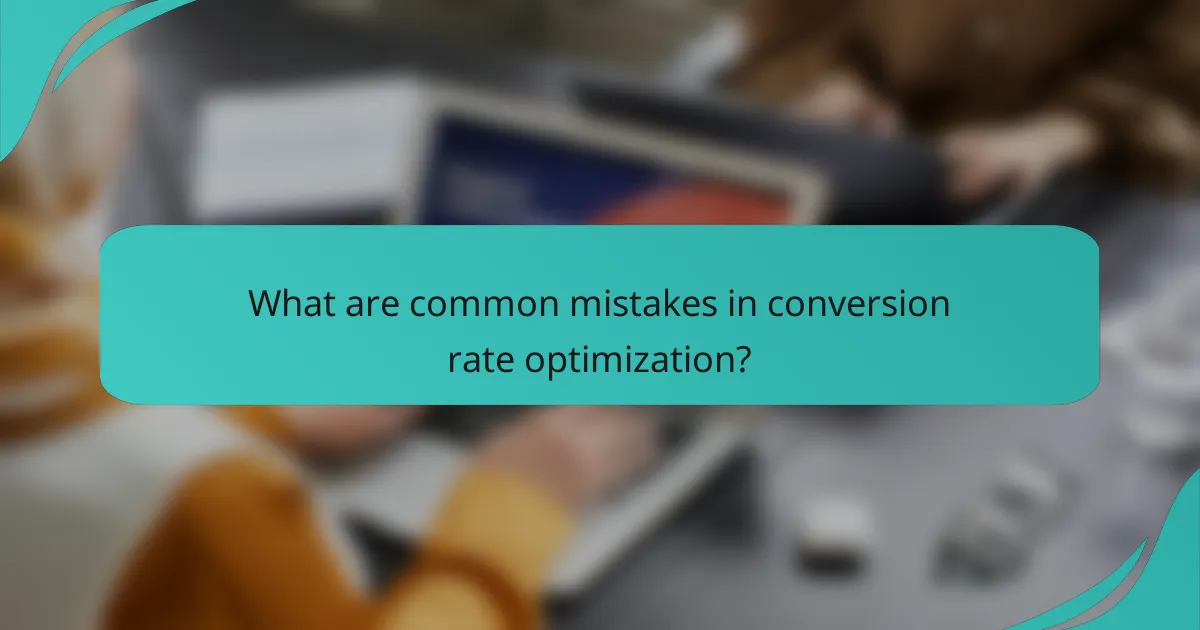
What are common mistakes in conversion rate optimization?
Common mistakes in conversion rate optimization (CRO) include overlooking critical user experience factors, failing to analyze data effectively, and neglecting mobile users. These errors can significantly hinder a website’s ability to convert visitors into customers.
Neglecting mobile optimization
Neglecting mobile optimization is a significant mistake that can drastically reduce conversion rates. With a large portion of web traffic coming from mobile devices, ensuring that your site is responsive and user-friendly on smartphones and tablets is crucial.
To optimize for mobile, focus on fast loading times, easy navigation, and clear calls to action. Aim for loading times under three seconds and ensure buttons are easily clickable without zooming. Consider using mobile-specific layouts that prioritize essential information and minimize distractions.
Common pitfalls include using large images that slow down load times and complex forms that are hard to fill out on smaller screens. Regularly test your site on various devices to identify and fix any usability issues that may arise.




